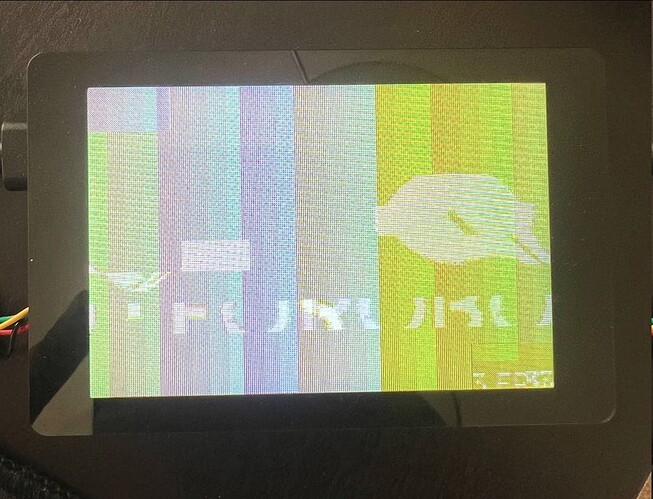Hi,
I am running a squareline exported lvgl code on ESP IDE for WT32-SC01 Plus Touch LCD which has a ESP32 S3 MCU.
If I set the color depth of squreline to 32 and export a single page and No image (Basically the simplest and lightest export from squreline) it crashes when I try to flash due to D/IRAM overflow.
Obviously I am doing something wrong because, I am running the most basic UI exported from squreline.
Does anyone have an idea why this is happening.
here is the error:
app-template.elf section .dram0.bss’ will not fit in region dram0_0_seg’
DRAM segment data does not fit.
Used stat D/IRAM: 400622 bytes ( -54766 remain, 115.8% used) Overflow detected! You can run idf.py size-files for more information.
.data size: 10736 bytes
.bss size: 321096 bytes
.text size: 67763 bytes
.vectors size: 1027 bytes
Here is the code:
#include <lvgl.h>
#include <demos/lv_demos.h>
#include "ui.h"
#include "LGFX_MakerFabs_Parallel_S3.hpp"
/ these do not have to be the same, not sure what is optimal
#define TASK_SLEEP_PERIOD_MS 1
#define LV_TICK_PERIOD_MS 1
#define LGFX_USE_V1
#define LV_DOUBLE_BUFFER
#define LANDSCAPE // if changing this, make sure to uncheck landscape in menuconfig -> components -> lvgl -> demos -> music
// if you get "will not fit, dram segment overflow" reduce this
#define LV_BUFFER_SIZE 80 /* if not double buffering, then buf will be 2x this */
static LGFX lcd;
/*** Setup screen resolution for LVGL ***/
static const uint16_t screenWidth = 480;
static const uint16_t screenHeight = 320;
static lv_disp_draw_buf_t draw_buf;
static lv_color_t buf[screenWidth * LV_BUFFER_SIZE];
static lv_color_t buf2[screenWidth * LV_BUFFER_SIZE];
/*** Function declaration ***/
static void display_flush(lv_disp_drv_t *disp, const lv_area_t *area, lv_color_t *color_p);
static void touchpad_read(lv_indev_drv_t *indev_driver, lv_indev_data_t *data);
static void lv_tick_task(void *arg);
static void init_lvgl_lgfx()
{
lcd.init();
lv_init();
lcd.setRotation(1);
lcd.setBrightness(255);
lcd.fillScreen(TFT_BLACK);
lv_disp_draw_buf_init(&draw_buf, buf, buf2, screenWidth * LV_BUFFER_SIZE);
/*** LVGL : Setup & Initialize the display device driver ***/
static lv_disp_drv_t disp_drv;
lv_disp_drv_init(&disp_drv);
disp_drv.hor_res = screenWidth;
disp_drv.ver_res = screenHeight;
disp_drv.flush_cb = display_flush;
disp_drv.draw_buf = &draw_buf;
lv_disp_drv_register(&disp_drv);
/*** LVGL : Setup & Initialize the input device driver ***/
static lv_indev_drv_t indev_drv;
lv_indev_drv_init(&indev_drv);
indev_drv.type = LV_INDEV_TYPE_POINTER;
indev_drv.read_cb = touchpad_read;
lv_indev_drv_register(&indev_drv);
/* Create and start a periodic timer interrupt to call lv_tick_inc */
const esp_timer_create_args_t periodic_timer_args = {
.callback = &lv_tick_task,
.name = "periodic_gui"};
esp_timer_handle_t periodic_timer;
ESP_ERROR_CHECK(esp_timer_create(&periodic_timer_args, &periodic_timer));
ESP_ERROR_CHECK(esp_timer_start_periodic(periodic_timer, LV_TICK_PERIOD_MS * 1000));
}
/*** Display callback to flush the buffer to screen ***/
static void display_flush(lv_disp_drv_t *disp, const lv_area_t *area, lv_color_t *color_p)
{
uint32_t w = (area->x2 - area->x1 + 1);
uint32_t h = (area->y2 - area->y1 + 1);
lcd.startWrite();
lcd.setAddrWindow(area->x1, area->y1, w, h);
lcd.writePixels((uint16_t *)&color_p->full, w * h, true);
lcd.endWrite();
lv_disp_flush_ready(disp);
}
/*** Touchpad callback to read the touchpad ***/
static void touchpad_read(lv_indev_drv_t *indev_driver, lv_indev_data_t *data)
{
uint16_t touchX, touchY;
bool touched = lcd.getTouch(&touchX, &touchY);
if (!touched)
{
data->state = LV_INDEV_STATE_REL;
}
else
{
data->state = LV_INDEV_STATE_PR;
/*Set the coordinates*/
data->point.x = touchX;
data->point.y = touchY;
}
}
/* Setting up tick task for lvgl */
static void lv_tick_task(void *arg)
{
(void)arg;
lv_tick_inc(LV_TICK_PERIOD_MS);
}
void SW_initialize(void)
{
init_lvgl_lgfx();
ui_init();
}
void Rate_0(void *pvParameter) /* Sample time: [0.1s, 0.0s] */
{
TickType_t xLastWakeTime;
const TickType_t xFrequency = 1 / portTICK_PERIOD_MS; // 5 Hz
xLastWakeTime = xTaskGetTickCount();
while (1) {
lv_timer_handler();
vTaskDelayUntil(&xLastWakeTime, xFrequency);
}
}
extern "C" void app_main(void)
{
/* Initialize model */
SW_initialize();
xTaskCreatePinnedToCore(Rate_0, "Rate_0", STACK_SIZE, NULL, configMAX_PRIORITIES-
}

